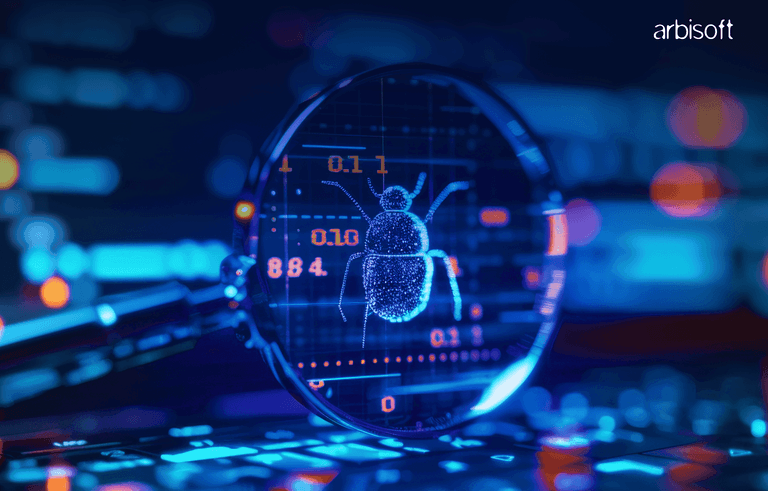We put excellence, value and quality above all - and it shows




A Technology Partnership That Goes Beyond Code

“Arbisoft has been my most trusted technology partner for now over 15 years. Arbisoft has very unique methods of recruiting and training, and the results demonstrate that. They have great teams, great positive attitudes and great communication.”
Driving Digital Transformation: Exploring Technical Trends

If we talk about digital transformation, innovation is the currency of success. Beyond the commonplace, the advanced technical trends we explore in this blog represent the progress and growth of digital evolution. These are the trends that are redefining industries, revolutionizing business paradigms, and propelling organizations into a future where technology knows no bounds.
In this deep dive, we'll uncover the intricacies of these cutting-edge trends, offering insights and strategic perspectives to empower your journey into the digital frontier.
Moreover, understanding the transformative power of these trends becomes even more impactful when undertaken in collaboration with a digital transformation partner. These partners bring a wealth of experience, specialized knowledge, and a collaborative mindset to the table, ensuring that your exploration of the digital landscape is not only informed but also guided by expertise. Discover how aligning with a digital transformation partner can elevate your strategies and contribute to a more successful navigation of the dynamic digital terrain here.
Explore digital transformation best practices to delve even further into the realm of digital transformation and gain a comprehensive understanding of the most effective methods and their real-world application.
Digital Transformation: The Evolving Tech Landscape
In today's interconnected world, digital transformation has become imperative for organizations seeking to stay competitive and relevant. The digital transformation journey is not only about embracing new technologies but also about understanding how the technological landscape continually evolves. This evolution necessitates a keen awareness of emerging tech trends, as they have a profound impact on business strategies, operations, and customer experiences.
Now let’s explore its dynamic nature, highlighting key trends that are shaping the digital transformation landscape and propelling organizations toward a more innovative and adaptive future.
Quantum Computing: The Quantum Leap
Quantum computing, considered an obscure realm until recently, now commands the spotlight. This revolutionary technology leverages the principles of quantum mechanics to perform computations at speeds that defy the imagination.
As organizations begin to grasp the implications of quantum computing, they are exploring its potential for solving complex problems, optimizing supply chains, and revolutionizing cryptography.
DeFi and DAOs: Decentralization Reshaping Finance
DeFi (Decentralized Finance) and DAOs (Decentralized Autonomous Organizations) play a pivotal role in driving digital transformation. DeFi, by enabling peer-to-peer financial services and reducing reliance on intermediaries, promotes inclusivity and trust in a wide range of financial transactions.
In contrast, DAOs operate through code and consensus, enhancing transparency while diminishing central authority in decision-making processes. Beyond the realm of finance, these innovations extend into sectors such as supply chain management and healthcare, where they introduce transparency, efficiency, and trust, thereby reshaping traditional practices and accelerating digital transformation across industries.
Edge AI: Intelligence at the Edge
Edge AI, also known as Edge Artificial Intelligence, is a groundbreaking technology that represents a pivotal aspect of the ongoing digital transformation. It shifts the traditional AI paradigm by bringing intelligence directly to the "edge" of networks where data is generated, eliminating the need for centralized data centers and cloud computing. Edge AI achieves this by embedding AI algorithms and machine learning models into edge devices like smartphones, IoT sensors, and local servers.
This approach not only enhances data privacy and security but also facilitates real-time decision-making, reducing latency for applications such as autonomous vehicles, industrial automation, and healthcare diagnostics. As the world becomes increasingly connected, Edge AI exemplifies how digital transformation is driving the deployment of intelligent, decentralized solutions across various industries, fundamentally reshaping our interaction with artificial intelligence.
5G-Empowered Edge Computing: Where Speed Meets Precision
5G-empowered Edge Computing represents a pivotal intersection of cutting-edge technology in the realm of telecommunications and computing. This transformative concept unites the lightning-fast data speeds of 5G networks with the precision and agility of edge computing. 5G networks provide unparalleled connectivity with minimal latency, enabling seamless communication between devices and applications.
When combined with edge computing, which processes data closer to its source, this synergy unlocks a multitude of possibilities across industries such as autonomous transportation, augmented reality, and industrial automation. The result is a technology ecosystem where speed meets precision, revolutionizing how data is processed, shared, and harnessed in our increasingly connected and data-dependent world.
Generative Adversarial Networks (GANs): Artistry in AI
GANs are the artists of the digital realm. Generative Adversarial Networks (GANs) are a remarkable manifestation of artificial intelligence, exemplifying the fusion of technology and artistry. These sophisticated AI models consist of two neural networks, the generator, and the discriminator, locked in a creative duel. The generator crafts data, whether it be images, text, or music, while the discriminator critiques and distinguishes it. Through this adversarial process, GANs produce astonishingly realistic and imaginative outputs, fueling applications in art, design, and content generation.
As a testament to the transformative power of AI, GANs stand as a pioneering force in digital transformation, opening new frontiers for creative expression and innovation across various domains.
Explainable AI (XAI): Illuminating the Black Box
Explainable AI (XAI) serves as a linchpin for organizations pursuing digital transformation. By demystifying the inner workings of AI models and rendering them transparent, XAI engenders trust and informed decision-making. This newfound transparency enhances the adoption of AI across various industries, as stakeholders can comprehend the reasoning behind AI-driven choices, making it easier for organizations to integrate AI into their digital strategies and operations effectively.
Furthermore, XAI fosters accountability and compliance, a critical aspect of digital transformation. Organizations can align AI applications with regulatory frameworks and industry standards more easily, mitigating risks associated with AI adoption. Ultimately, XAI's ability to illuminate the AI decision-making process not only boosts trust but also empowers organizations to harness the full potential of AI in their transformative endeavors.
Biotechnology Integration: The Fusion of Digital and Biological
Biotechnology Integration represents a transformative nexus where the digital world converges with the biological realm. Merging digital technologies with the biological sciences, it unlocks a new realm of possibilities. This integration, coupled with advanced software development services that support agile innovation, facilitates accelerated innovation cycles, enabling organizations to bring products and solutions to market more swiftly, a critical advantage in today's fast-paced business landscape.
Additionally, the convergence of digital and biological data empowers organizations with deep insights into complex biological systems. This data-driven approach enhances decision-making, enabling organizations to optimize processes, identify new opportunities, and drive efficiencies. Whether in healthcare, agriculture, or research, Biotechnology Integration provides a transformative avenue for organizations to harness the full potential of digital technologies and reshape their operations for a more sustainable and innovative future.
Neuromorphic Computing: Minds of Machines
Neuromorphic Computing is a visionary frontier in the world of artificial intelligence, akin to forging the minds of machines. This cutting-edge approach to computing draws inspiration from the human brain's architecture, creating artificial neural networks that mimic the brain's structure and function.
Neuromorphic systems excel at tasks like pattern recognition, sensory processing, and real-time learning, all while consuming minimal power. By replicating the brain's cognitive abilities, Neuromorphic Computing promises to revolutionize AI applications in robotics, sensor networks, and edge computing. This technology represents a profound step toward building more efficient, adaptable, and intelligent machines that can process information and make decisions with remarkable human-like capabilities.
Digital Twins and Simulation Technologies: Mirrors to the Future
Digital Twins and Simulation Technologies serve as futuristic mirrors, offering remarkable insights into the virtual replication of real-world systems and processes. These cutting-edge technologies create digital counterparts of physical assets, environments, or systems, enabling real-time monitoring, analysis, and experimentation.
By harnessing the power of data, IoT sensors, and advanced modeling, Digital Twins and Simulation Technologies enhance decision-making, optimize operations, and drive innovation across various domains, including manufacturing, healthcare, and urban planning. They represent a transformative force, allowing us to foresee and shape the future with unparalleled accuracy and efficiency.
Bioinformatics and Computational Biology: Data-Driven Biology
Bioinformatics and Computational Biology are integral components of the ongoing digital transformation within the life sciences and healthcare sectors. They exemplify how digital technologies have revolutionized the way biological data is collected, analyzed, and leveraged for scientific discovery and practical applications. The digital transformation in these fields has accelerated the pace of research, enabling scientists and healthcare professionals to process vast datasets, identify patterns, and develop personalized treatment strategies.
Furthermore, it has facilitated the integration of diverse data sources, such as genomics, clinical records, and environmental factors, to provide a holistic view of health and disease. In essence, Bioinformatics and Computational Biology are at the forefront of leveraging digital tools and techniques to drive innovation, improve patient outcomes, and advance our understanding of the biological world.
The Takeaway
In the ever-evolving landscape of digital transformation, understanding these advanced technical trends is not merely a choice; it is the key to unlocking the next level of innovation and competitiveness. These are the stepping stones to reshaping industries and pioneering new business models. As you navigate this dynamic landscape, remember that the advanced trends are not destinations but waypoints on a journey of continuous transformation. Embrace them and you'll forge a path into an ever more limitless digital future.
Discover the ins and outs of digital transformation – what digital transformation is and how to execute it successfully – by exploring best practices and expert insights.
























